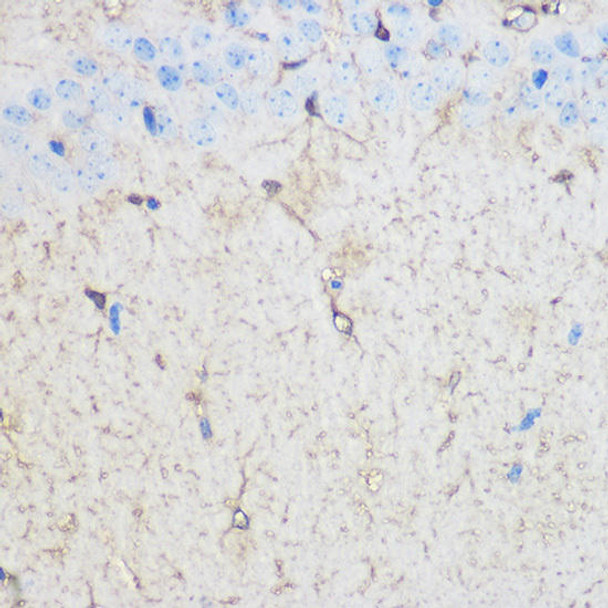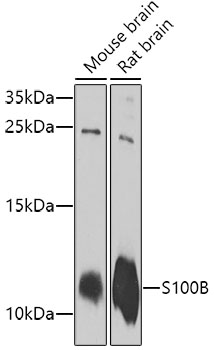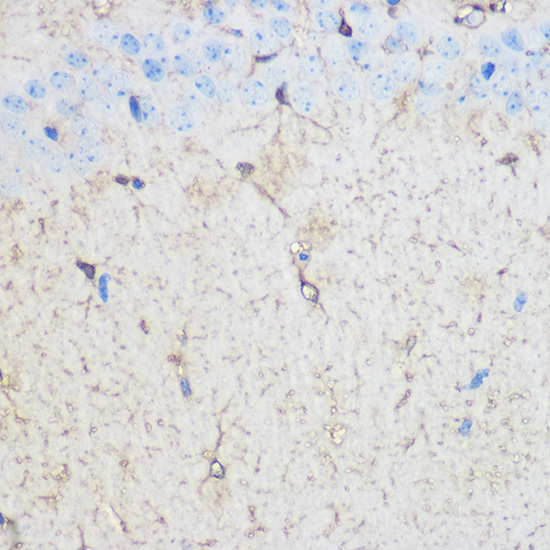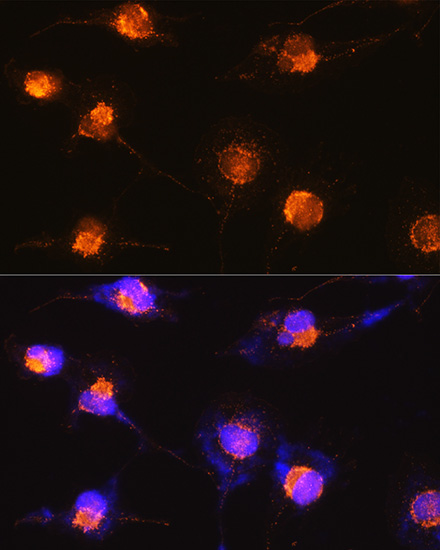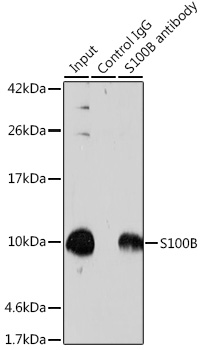Anti-S100B Antibody (CAB0676)
- SKU:
- CAB0676
- Product type:
- Antibody
- Reactivity:
- Human
- Mouse
- Rat
- Host Species:
- Rabbit
- Isotype:
- IgG
- Antibody Type:
- Polyclonal Antibody
- Research Area:
- Cell Biology
Description
| Antibody Name: | Anti-S100B Antibody |
| Antibody SKU: | CAB0676 |
| Antibody Size: | 20uL, 50uL, 100uL |
| Application: | WB IHC IF IP |
| Reactivity: | Human, Mouse, Rat |
| Host Species: | Rabbit |
| Immunogen: | Recombinant fusion protein containing a sequence corresponding to amino acids 1-92 of human S100B (NP_006263.1). |
| Application: | WB IHC IF IP |
| Recommended Dilution: | WB 1:500 - 1:2000 IHC 1:50 - 1:200 IF 1:50 - 1:200 IP 1:50 - 1:200 |
| Reactivity: | Human, Mouse, Rat |
| Positive Samples: | Mouse brain, Rat brain |
| Immunogen: | Recombinant fusion protein containing a sequence corresponding to amino acids 1-92 of human S100B (NP_006263.1). |
| Purification Method: | Affinity purification |
| Storage Buffer: | Store at -20°C. Avoid freeze / thaw cycles. Buffer: PBS with 0.02% sodium azide, 50% glycerol, pH7.3. |
| Isotype: | IgG |
| Sequence: | MSEL EKAM VALI DVFH QYSG REGD KHKL KKSE LKEL INNE LSHF LEEI KEQE VVDK VMET LDND GDGE CDFQ EFMA FVAM VTTA CHEF FEHE |
| Gene ID: | 6285 |
| Uniprot: | P04271 |
| Cellular Location: | Cytoplasm, Nucleus |
| Calculated MW: | 10kDa |
| Observed MW: | 11kDa |
| Synonyms: | NEF, S100, S100-B, S100beta, S100B, S100 beta |
| Background: | The protein encoded by this gene is a member of the S100 family of proteins containing 2 EF-hand calcium-binding motifs. S100 proteins are localized in the cytoplasm and/or nucleus of a wide range of cells, and involved in the regulation of a number of cellular processes such as cell cycle progression and differentiation. S100 genes include at least 13 members which are located as a cluster on chromosome 1q21; however, this gene is located at 21q22.3. This protein may function in Neurite extension, proliferation of melanoma cells, stimulation of Ca2+ fluxes, inhibition of PKC-mediated phosphorylation, astrocytosis and axonal proliferation, and inhibition of microtubule assembly. Chromosomal rearrangements and altered expression of this gene have been implicated in several neurological, neoplastic, and other types of diseases, including Alzheimer's disease, Down's syndrome, epilepsy, amyotrophic lateral sclerosis, melanoma, and type I diabetes. |
| UniProt Protein Function: | S100B: Weakly binds calcium but binds zinc very tightly- distinct binding sites with different affinities exist for both ions on each monomer. Physiological concentrations of potassium ion antagonize the binding of both divalent cations, especially affecting high-affinity calcium-binding sites. Binds to and initiates the activation of STK38 by releasing autoinhibitory intramolecular interactions within the kinase. Interaction with AGER after myocardial infarction may play a role in myocyte apoptosis by activating ERK1/2 and p53/TP53 signaling. Dimer of either two alpha chains, or two beta chains, or one alpha and one beta chain. The S100B dimer binds two molecules of STK38. Interacts with AGER. The S100B dimer interacts with two molecules of CAPZA1. Although predominant among the water-soluble brain proteins, S100 is also found in a variety of other tissues. Belongs to the S-101 family. |
| UniProt Protein Details: | Protein type:Calcium-binding Chromosomal Location of Human Ortholog: 21q22.3 Cellular Component: ruffle; extracellular space; cell soma; intracellular membrane-bound organelle; perinuclear region of cytoplasm; cytoplasm; extracellular region; nucleus Molecular Function:identical protein binding; protein binding; RAGE receptor binding; protein homodimerization activity; zinc ion binding; calcium ion binding; calcium-dependent protein binding; tau protein binding Biological Process: central nervous system development; positive regulation of I-kappaB kinase/NF-kappaB cascade; positive regulation of apoptosis; response to glucocorticoid stimulus; memory; cell proliferation; regulation of cell shape; learning and/or memory; astrocyte differentiation; axonogenesis; response to methylmercury; positive regulation of cell proliferation; innate immune response; regulation of neuronal synaptic plasticity |
| NCBI Summary: | The protein encoded by this gene is a member of the S100 family of proteins containing 2 EF-hand calcium-binding motifs. S100 proteins are localized in the cytoplasm and/or nucleus of a wide range of cells, and involved in the regulation of a number of cellular processes such as cell cycle progression and differentiation. S100 genes include at least 13 members which are located as a cluster on chromosome 1q21; however, this gene is located at 21q22.3. This protein may function in Neurite extension, proliferation of melanoma cells, stimulation of Ca2+ fluxes, inhibition of PKC-mediated phosphorylation, astrocytosis and axonal proliferation, and inhibition of microtubule assembly. Chromosomal rearrangements and altered expression of this gene have been implicated in several neurological, neoplastic, and other types of diseases, including Alzheimer's disease, Down's syndrome, epilepsy, amyotrophic lateral sclerosis, melanoma, and type I diabetes. [provided by RefSeq, Jul 2008] |
| UniProt Code: | P04271 |
| NCBI GenInfo Identifier: | 134138 |
| NCBI Gene ID: | 6285 |
| NCBI Accession: | P04271.2 |
| UniProt Secondary Accession: | P04271,D3DSN6, |
| UniProt Related Accession: | P04271 |
| Molecular Weight: | 10,713 Da |
| NCBI Full Name: | Protein S100-B |
| NCBI Synonym Full Names: | S100 calcium binding protein B |
| NCBI Official Symbol: | S100B |
| NCBI Official Synonym Symbols: | NEF; S100; S100-B; S100beta |
| NCBI Protein Information: | protein S100-B; S-100 protein subunit beta; S-100 calcium-binding protein, beta chain; S100 calcium-binding protein, beta (neural) |
| UniProt Protein Name: | Protein S100-B |
| UniProt Synonym Protein Names: | S-100 protein beta chain; S-100 protein subunit beta; S100 calcium-binding protein B |
| Protein Family: | Protein |
| UniProt Gene Name: | S100B |
| UniProt Entry Name: | S100B_HUMAN |

